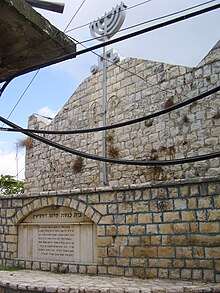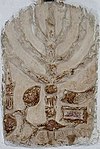Peki'in Synagogue
| Peki'in Synagogue | |
|---|---|
 | |
| Religion | |
| Year consecrated | 1873 |
| Location | |
| Location | Peki'in |
The Peki’in Synagogue (Hebrew: בית הכנסת העתיק בפקיעין The Ancient Synagogue in Peki'in), is a synagogue located in the centre of Peki'in, Northern Israel, said to have built into its walls two stones taken from the walls of the Jewish Temple in Jerusalem.

According to local tradition the synagogue was built on the site of the Beth midrash, where Rabbi Joshua ben Hananiah has taught before the Bar Kokhba war, and Rabbi Shimon bar Yochai after it. The current structure dates from 1873 after the former one destroyed by an earthquake 30 years before. Funding for the construction, attested to on a plaque commemorating the donation, was given by a Jew named Rafael Halevy from Beirut.
In 1926 and 1930 two old stone tablets were uncovered at the synagogue. One depicts a menorah, shofar and lulav and the second depicts a Torah shrine. Both are dated between the late 2nd century CE and the early 3rd.[1]
In 1955 the Israeli Ministry of Religious Affairs renovated the building at the request of president Yitzhak Ben-Zvi who had visited the Jewish community of Peki’in in 1922 and documented it in his book Shaar Yashuv.[2] To this end the 100 NIS banknote which features Yitzhak Ben-Zvi, also features the Peki’in synagogue on the reverse side.[3]
The synagogue, not usually active, is kept by Margalit Zinati. Zinati is of a Jewish family who have lived for centuries in Peki’in, reportedly since the time of the Second Temple.[4]
References
- ^ Joyce Segal Chiat, Marilyn (1982). Handbook of Synagogue Architecture. Brown Judaic Studies. Vol. 29. Scholars Press. pp. 53–54. ISBN 978-0-89130-524-8.
- ^ Researchers race to document vanishing Jewish heritage of Galilee Druze village, Eli Ashkenaz, 25 July 2012, Haaretz
- ^ "Banknotes and Coins Catalog; Second Series of the New Sheqel: One Hundred New Sheqalim". Bank of Israel. Retrieved 2007-07-04.
- ^ "Cities: Peki'in (Buke'a)". ThinkIsrael.com/Tourism Ministry (Israel). Retrieved 2007-07-04.
Further reading
- I. Ben-Zevi. "Discoveries at Pekiin." Palestine Exploration Fund Quarterly Statement, 62(4), pp. 210–214. doi:10.1179/peq.1930.62.4.210
- E. L. Sukenik. "Designs of the Torah Shrine in Ancient Synagogues in Palestine." Palestine Exploration Fund Quarterly Statement, 63(3), pp. 22–25. doi:10.1179/peq.1931.63.1.22
